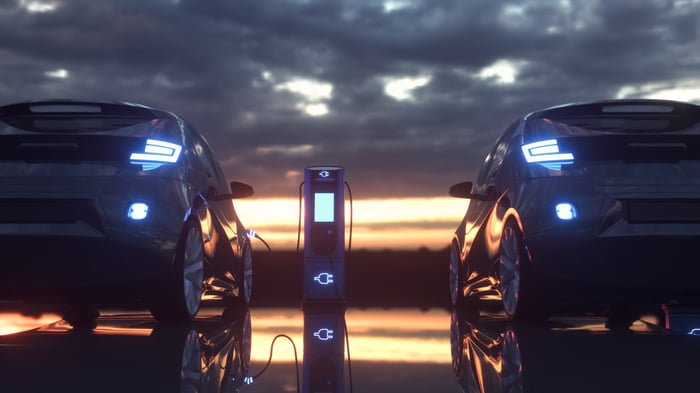It's no secret that hybrid and electric vehicles (EVs) are the future of the automotive industry. The word is out, and consequently, growth investors have been willing to pay hand over fist. But instead of paying sky-high valuations to pick a winner among EV manufacturers, why not buy an attractively priced supplier? Here's the investment case for Magna International (MGA 0.19%).

Image source: Getty Images.
Long-term opportunity
The challenges and opportunities ahead for auto suppliers are simple to understand. How relevant will they be in the transition from internal combustion engines (ICE) to hybrid and electric vehicles? It's a question Magna's management doesn't have to fear. Simply put, most of its sales come from parts that are either agnostic to the shift or benefit from the transition.
Magna's agnostic parts include lighting, body exteriors, seating, mirrors, and dual-clutch transmissions. And it can benefit from the new trends with its electric drive systems, advanced driver assistance systems (ADAS), battery enclosures, and even contract vehicle manufacturing. An example of the latter comes from Magna's contract manufacturing agreement with Fisker -- Magna is also developing ADAS for Fisker.
On the downside, Magna is expected to see less demand for its manual transmissions, fuel tanks, and four-wheel-drive systems. Still, it's important to note that these products are not unprofitable, and Magna should still be able to generate profits and cash flow from them to invest in its growth platforms.

Data source: Magna International presentations.
Moreover, Magna's management argues that its content per vehicle will rise as ICE shifts to EV due to higher pricing on electric drive systems and increased "take up" rates of its technology on EVs than on ICE vehicles. For example, all EVs require primary electric drive systems. Meanwhile, only 40% of ICE vehicles use dual-clutch/manual transmission systems.
Near-term challenges
There's no way around the fact that sales at original equipment manufacturer (OEM) auto parts suppliers correlate with global light vehicle production (LVP.) As a result, the weakness in LVP in recent years has hung over the stock. The COVID-19 pandemic has made matters a lot worse. For example, automakers have had to cut back on production plans due to a shortage of semiconductors, supply constraints for certain items, and employee absenteeism. Indeed, Magna was forced to lower its full-year sales and profit margin guidance in October due to lower expected LVP and increased raw material and production costs.

Image source: Getty Images.
Magna's management now expects its full-year 2021 sales to be in the range of $35.4 billion to $36.4 billion compared to a previous range of $38 billion to $39.5 billion. These negative issues are likely to extend at least into the start of 2022, and given that most of them are pandemic-related, it's tough to predict when they will ease.
Near-term opportunities
That said, Magna's valuation already reflects a lot of the bad news. In addition, the potential for a multiyear recovery in LVP, and consequently, Magna's sales growth and profit margin expansion, is significant. History suggests the semiconductor shortage will ease as capacity comes online, and there's already evidence of an easing in key indicators of supply chain pressures, such as container freight rates.
Wall Street analysts have Magna's sales bouncing 11% in 2022, with free cash flow (FCF) ramping from $1 billion in 2021 to $1.8 billion in 2022 and then $2.3 billion. To put the latter into context, based on the stock's current market cap of $26.8 billion, Magna would trade at 14.9 times FCF in 2022 and then 11.7 times FCF in 2023.
As you can see below, those are excellent valuations from a historical perspective. Note that the valuation fell in 2017-2019 to reflect global car production declines in 2018 and 2019.
Magna International. Data by YCharts.
If the industry does indeed enter a multiyear recovery period and Magna merely hits Wall Street estimates, then the upside potential in the stock is significant.
A stock to buy
Magna has near-term negative risk, but it also has plenty of positive risk according to market estimates. Meanwhile, the company is preparing for long-term growth from the transition toward EV production. As such, Magna's sales and profits can grow more than a market that's already in recovery mode. As a result, Magna is an attractive stock if you can tolerate some likely volatility in 2022.






